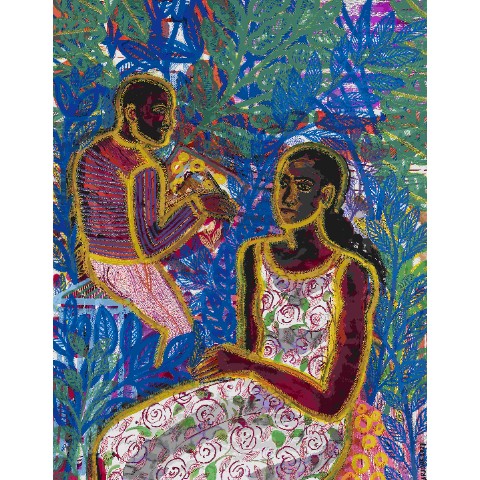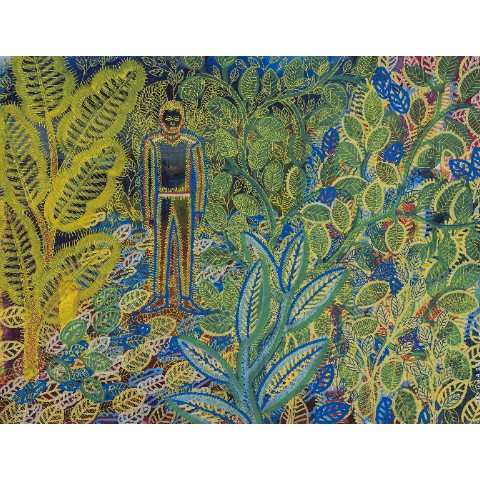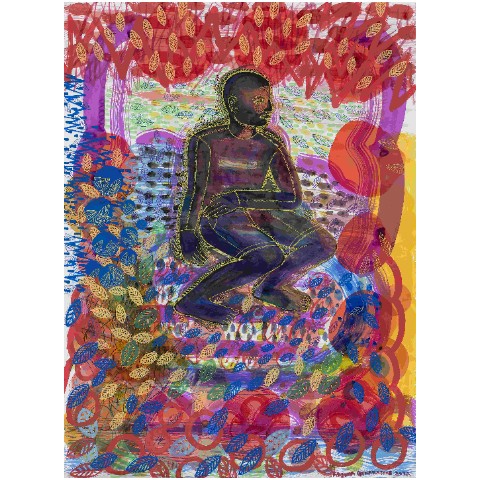
SOLITARY GARDENS - ARJUNA GUNARATHNE
November 23 - December 27 , 2024
An unsettling sense of longing simmers in the lush compositions of Arjuna Gunarathne’s work. His family, neighbours and occasionally stories of co-immigrants find refuge in these fantastical leafy gardens and dense groves. Green becomes a surrogate for home, sometimes growing into domestic spaces and the crevices of the mind.
The foliage envelopes his protagonists like it was a warm hug, a space to hide, weep and probably heal. They sit, are hard at work, lost in thought or exploring like they were looking for something in these milieus. That these British pleasure gardens may well have residues of home in the form of flora from colonial Sri Lanka (where Gunarathne hails from) offers a distant, but possible trace of home. He also actively seeks these spaces of solitude and suspension, rest and recuperation in the bustle of the British metropolis, its tall, glass towers, brick facades and wet, sunless days. Possibly the only work in which we see the city is Talking, 2023, where two men engage in a conversation against the grey, stony arched backdrop of the city.
Born in Sri Lanka, Arjuna studied in three different academic traditions - the alternative Vibhavi Academy in Colombo; Beaconhouse, Lahore, where he studied mughal miniature painting and the British Academic style of painting at the Royal Drawing School in London. Other early influences include his grandfather’s jewellery making practice (thus the interest in miniature) and traditional painters in his extended family. During his time in London, an exposure to the masters and classical paintings along with impressionism, Japanese, Chinese and Indian styles and principles of paintings also influenced his technique and textural quality. Gunarathne is a keen observer, observing lines, textures, rhythms and the movement it produces visually and as an experience. His works also have two lives - one rendered in the lightness and fluidity of ink and water colours and the second in the thick, voluminous density of oil paints.
It is in the confluence and collision of these Eastern and Western influences, that Gunarathne divines his own language and palette. He is drawn to the possibility of passing through several histories of art across time and contexts spanning South Asian, classical, religious or academic painting.There is an urgency to Gunarathne’s method. He is restless and spontaneous, immediately at work once he’s connected to a thought, sensation or a story. The process of recollection and revision by returning to an image over and over again to find new revelations or interpretations remains a constant exercise.
Often contemplating his daily life and the need to find ordinariness in this unfamiliar place - he continues to delve into the complexities of immigrant life - and the sensations of strangeness and otherness. This also produces an interiority where a large part of his interactions are with his wife and children. The inter-dependence is palpable in his positioning of bodies in space - a parent leads the way while the child follows or they watch over a child play; the family also cocoons in foliage enclosures in a huddle, occasionally extending a hand to hold or touch. His family provides both stability and comfort in this surreal feeling of suspension and un-belonging.
An immigrant to the global north from the Southern world, is almost always hard at work to economically justify voluntary displacement and the emotional distress it causes. Gunarathne, who works/worked odd hours at a supermarket, documents constantly in order to not miss out on experiences with his family while trying to make ends meet. His children and partner feature prominently across his work as though he were compensation or filling gaps of missed moments. These moments are not necessarily special but deeply tied to how they spend their day and time when he is away at work or in his studio. Other times, he looks at the society and the world outside from this intimate space, interacting with it on chance occasions. The experience of strangeness is two fold. There's the collective feeling and then there’s an individual, solitary coming to terms with. We see them look in different directions, their stares held in contemplation. His ink and pigment pen Together, 2024 brings together both these states.
Gunarathne is also interested in cultural collisions and the violence of “fitting in” or “assimilating” without the sensation of belonging. In some works, colours in their bright, generous use offer a hyper visibility of these emotions and situations and then in some he pares them down to few colours.
The trope of the holiday, which in South Asia still follows the British calendar list (along with regional and national holidays), Gunarathne invokes the bank holiday (Bank Holiday 1, 2023) as a bureaucratic day of rest or day off (Off day, 2023) as a rotational day of rest in the life of a sales or maintenance employee.
Another way to look at this body of work is to read it as a sequence of movements, a quest that continues after occasional moments of repose and regeneration. His titles remain diaristic, simple and matter of fact. The cyclical also references the mundaneness and rut of working-class life in big, western cities, migrating to which is fetishised in South Asia as a change of fortunes.
Gunarathne strives to find forms and situations to communicate this uncertainty, anxiety and anticipation - of neither belonging here nor there. These are landscapes of the mind and heart, of loss and longing and almost never geographical. In that he assigns himself and his family to the natural, as though it were a third space, a framework that accepts everyone.
-Mario D'Souza
Images



